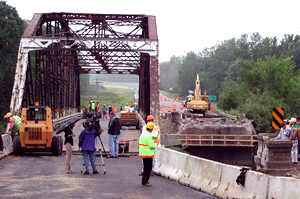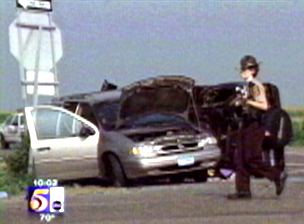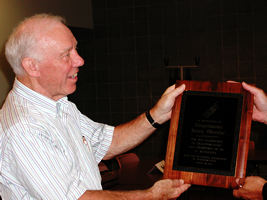 |
 |
|
 |
District 1 moves old bridge aside to make room for the new |
 |
 |
 |
A TV news crew filmed the final stage of moving the vintage Hwy 200
bridge over the Mississippi to allow construction of a new, wider structure.
Photo by Maureen Talarico
|
Sometimes you just have to take the bull—or the bridge—by the horns and move
it. That’s what Duluth/District 1 staff did when they moved
the Hwy 200 bridge over the Mississippi River at Jacobson
in Aitkin County in order to construct a new bridge at the
original site.
The 75-year-old, 174-ton steel bridge will temporarily connect a bypass road
until the new bridge opens sometime this fall or next spring. Crews took less
than three hours to move the bridge by using steel rollers and cables pulled
by winches.
Area residents—including one man who remembered the completion of the original
bridge crossing in 1927—applauded when crews relocated it, according to Maureen
Talarico, district public affairs coordinator. If District 1 had not relocated
the old bridge, she added, area residents would need to take a 45-mile detour
in order to cross the Mississippi River.
The relocated old bridge is only 19 feet wide and is difficult to maintain.
The new bridge will be 40 feet wide and of modern design. Dave Mavec, Virginia
Construction Office, serves as project manager.
By Craig Wilkins
|
back

|
 |
'At-risk' intersection prompts action and media attention |
 |
 |
 |
A State Patrol officer surveys a recent fatal crash at the intersection
of Hwy 52 and Dakota County Road 46 near Coates. The crash prompted
movement restrictions until stoplights have been installed. Photo
courtesy of KSTP-TV
|
The news media were well represented on Aug. 13 at a news conference held in
Coates, Minn., to announce new traffic restrictions for the
intersection of Hwy 52 and Dakota County Road 46. This intersection
has been the site of a series of crashes that resulted in
two fatalities since the newly constructed roadway opened
to the public in mid-June.
Motorists may no longer make left turns at this intersection
and cannot cross the median. Stoplights will be installed
to ensure greater safety. These changes resulted from a Mn/DOT
partnership with Dakota County and the Department of Public
Safety.
"I think this is an excellent example of how Mn/DOT
and DPS working together can quickly react to protect the
motoring public," said Kevin Smith, DPS communications
director. "As partners on the roadway, Mn/DOT constructs
and maintains the roads, while we enforce traffic laws to
keep the motoring public safe."
Mn/DOT has identified a list of Twin Cities metro area intersections
that are at risk, which includes this intersection. These
at-risk intersections have high "crash costs," and
collisions at these intersections cost more in injuries and
property damage than other Twin Cities intersections.
The top rated at-risk intersection in the Metro area is at
Hwy 169 and County Road 81 in Brooklyn Park. It is a signalized
intersection with high volume traffic that results in many
rear-end collisions. There have been 128 crashes at this intersection—86
with injuries between 1999 and 2001. Reconstruction of this
interchange is scheduled to begin in 2006.
The other top five at-risk intersections on the list include
Hwy 242 and Central Avenue in Blaine, which is ranked second.
During the past two years there have been 31 injuries at that
intersection, resulting in one death. The third-ranked intersection
is Hwy 100 and Hennepin County Road 81 in Robbinsdale where
Mn/DOT is currently constructing a new interchange.
The fourth highest at-risk intersection is also located in
Blaine. It is at Central Avenue and Cloud Drive. Although
there have been fewer crashes at this intersection than the
other one in Blaine, there were six crashes with serious injuries.
Currently there are no stoplights at that intersection. Mn/DOT
is working with the city to get one installed.
The fifth highest at-risk intersection is in Brooklyn Park
at Hwy 169 and 85th Avenue North. There have been 75 crashes
at that intersection between 1999 and 2001, with approximately
one-half of those resulting in injuries.
Statewide, the intersection with the greatest collision risk
is at Hwy 15 and Hwy 23 in St. Cloud.
Deputy Commissioner Doug Weiszhaar noted that legislators
could not agree on transportation choices or funding sources
even though transportation was a top priority for the 2002
legislative session. He added that this dramatically affects
Mn/DOT’s ability to deliver what the citizens of Minnesota
have clearly expressed as a need.
"Funding is an issue which is of great importance to
us," said Weiszhaar.
By Judy Jacobs
|
back

|
 |
Oberstar’s support for transportation earns recognition from Mn/DOT |
 |
 |
 |
U.S. Rep. James Oberstar receives a plaque honoring his advocacy for
transportation in Minnesota and around the country. Photo by Maureen
Talarico
|
Mn/DOT officials honored U.S. Rep. James Oberstar in Duluth on Monday, Aug.
19, for his efforts to enable the department to become a national leader in
transportation.
Oberstar received a plaque from Mn/DOT that recognized his efforts, which include
support for intelligent transportation system initiatives and for programs such
as the recently launched "511" automated traveler information system.
Commissioner Elwyn Tinklenberg presented the plaque at the Duluth/District 1
headquarters.
Oberstar, who represents Minnesota’s Eighth Congressional District, has served
in Congress since 1975. He is the ranking Democrat on the House Transportation
and Infrastructure Committee. He has previously chaired several transportation-related
subcommittees, including those on aviation, railroads and economic development.
He has earned widespread recognition for his advocacy for transportation, including
groups representing bicyclists, aviation, the maritime industry, road and transportation
builders as well as unions representing workers in transportation industries.
|
back

|
 |
New leadership series will use team approach on real projects |
 |
 |
Enhancing leadership skills and preparing department leaders to meet a variety
of management challenges are the goals of Mn/DOT’s Leadership Academy, a new
nine-month course that begins in September.
Program director Ron Bisek said that the Leadership Academy is linked to the
department’s succession planning effort, which seeks to develop potential senior
managers (e.g., office directors) to fill high-level leadership positions as
vacancies occur.
"Leadership is an ‘A’ priority for development in the training plan approved
by the Senior Management Team," he said.
The new Leadership Academy replaces the former Management Academy. Bisek said
the change was made to reduce costs and to focus on developing leadership skills
and exploring what leadership means at Mn/DOT. He added that it will initially
be offered only to managers, although future sessions may include supervisors
and other leaders in Mn/DOT.
"Developing leaders is critical to Mn/DOT’s work," said Doug Weiszhaar,
deputy commissioner. "We’re facing the potential loss of a lot of talented,
experienced leaders during the next few years because of retirements. We need
to ensure that their successors are well-trained and able to cope with the challenges
Mn/DOT will face in the years ahead."
The academy will open with a two-day session on Sept. 23-24 and then meet once
a month through June 2003 (excluding December 2002). Academy trainers will use
several learning techniques, including project teams that will work on actual
Mn/DOT issues while they learn.
Class topics will include managing change, building relationships, leading
employees, taking risks and being innovative.
Supervisors must nominate all candidates. Submit nomination forms to Marilyn
Heroff, Human Resources, by Sept. 6. Attendance is limited to 30 participants
per program offering. For more information, call Ron Bisek, Human Resources,
at 651/296-1361.
|
back

|
 |
Aeronautics’ State Fair display highlights evolution of aviation |
 |
 |
Several generations of aircraft ranging from the first passenger plane with
a fully enclosed cabin to a modern ultralight plane will be on display at the
State Fair exhibit co-sponsored by the Office of Aeronautics and the aviation
industry.
One aircraft on display will be the 1927 Fairchild FC2-2W, which carried four
passengers, could cruise slightly faster than 100 miles an hour, and could reach
an altitude of 15,000 feet. The Golden Wings Museum in Anoka loaned this aircraft
for display at the fair.
The exhibit will also include the "Trike" ultralight and an aircraft
engine display, as well as special activities for youth. Representatives from
Mn/DOT and the aviation industry will be on hand to greet visitors and discuss
aviation.
"The State Fair is a great venue for us to expose many thousands of people
to the excitement and pleasure of aviation," said Wayne Petersen, Office
of Aeronautics. "It’s fun to watch kids and adults discover aviation and
learn how important it is in our daily lives as well as to the economy and security
of the nation."
Fairgoers can find the Aeronautics display about one block east of Mn/DOT’s
main fair exhibit on Cooper Avenue near the Dairy Building.
|
back

|
 |
National conference in St. Paul to focus on people-powered transportation |
 |
 |
Human-powered transportation modes—walking and bicycling—will be the focus
of attention at the annual Pro Bike/Pro Walk Conference in St. Paul next month.
Participants at the conference—scheduled for Sept. 3-7—will explore methods
to make biking and walking safer and more feasible for people
to commute and recreate.
The National Center for Biking and Walking sponsors the event, which brings
experts in traffic, education, planning, engineering, safety and law enforcement
together to examine ways to expand walking and biking options. These experts
will review measures such as traffic calming, context-sensitive design, crosswalk
improvements and safely mixing motorized and non-motorized traffic to improve
the livability of America’s cities, towns and rural areas.
Darryl Anderson, state bicycle coordinator planner with the Sustainable Transportation
Initiatives Unit, said the sponsor chose the Twin Cities in part because Minneapolis
ranks first nationally in the percentage of people who commute by bike: 2.6
percent, according to the 2000 U.S. Census. Minneapolis also earned the Bicycle-Friendly
Community Award from the League of American Bicyclists in 2000.
Commissioner Elwyn Tinklenberg will deliver the opening remarks on Sept. 4
during the morning keynote session. Anderson and other Mn/DOT staff are working
with a Minnesota conference sponsor to help coordinate the event.
Two Mn/DOT staff members will lead presentations. They are: Carol Zoff, Environmental
Services, who will lead a workshop on development of the Mississippi River Trail
in Minnesota; and Mary Jackson, a research analyst with the Bikeways and Pedestrian
Unit. Jackson will moderate a discussion by Twin Cities area biking advocates
on their efforts to coordinate city, county, state and citizen organizations
in order to fill in the gaps in the already extensively developed regional bikeway
network.
Other agenda items of note include:
On Sept. 6 from 3:00-5:00 p.m. at the Radisson Riverfront Hotel in St. Paul,
a panel will review strategies for street design, law enforcement and funding
to make streets more inviting for cycling and walking.
On Sept. 7 at the Landmark Center in St. Paul, experts in traffic calming,
transit and cycling will lead a workshop exploring ways schools can encourage
students to walk or bike to school as well as other methods to increase walking,
biking and transit use.
Following the conference, two free workshops will explore ways for communities
to encourage walking and biking.
For information about the conference or to register, visit
the following Web site: http://www.bikewalk.org/Conference/schedule.htm
|
back

|
 |
|
 |



